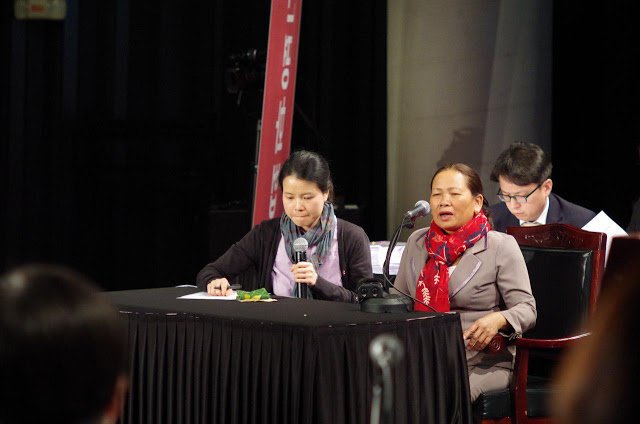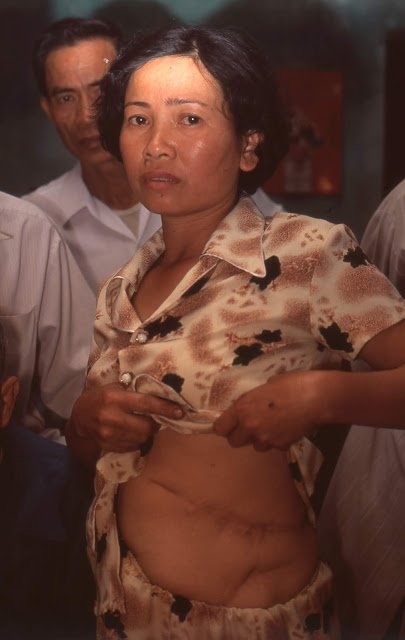Precursor to the Mỹ Lai Massacre: 1968 Phong Nhị, Phong Nhất_10(2)
Chapter 10(2) : Nguyễn Thị Thanh visits Korea as a Victim of the Massacre

Nguyễn Thị Thanh, who appeared as a plaintiff at the Vietnam Civil Peace Court held at the Culture Reserve Base in Mapo-gu, South Korea testifying what she experienced on February 12, 1968. Photo by Korea-Vietnam Peace Foundation
I have met with Nguyễn Thị Thanh a number of times.
At first, I was able to count how many times; but after a while, I lost track, as the encounters grew more frequent.
Starting with what I could recount, I recall our first encounter to be in April of 2001. Nguyễn Thị Thanh was among the crowd that gathered after hearing that a Korean reporter had photographs of corpses from the Phong Nhị, Phong Nhất massacre. She distinguished the photograph containing her family members and explained how her older sister, Thị Trọng, her younger brother, Đức Trường, her aunt, Thị Ngư, and her friend, Trịnh Chờ were killed. She then lifted up her shirt. On her left side was wrinkled and caved in. It was her gunshot wound. She explained how the littlest change in weather would strain her stomach. She would have to take deep breaths before the tightness and pain would subside.

Nguyễn Thị Thanh, whom I met for the first time in May of 2001. Showing me the scar on her stomach. Photo by humank
Our second encounter was in January of 2013. I visited her home located near the number 1 national highway. Twelve years had gone by since. She recognized me as she smiled saying, “You used to look much younger back then...” Then she cried as she recounted what happened at the time and how she spent the years thereafter. “I was released from the hospital in Da Nang after one year of being treated from the gunshot wound. I returned home to find nobody there. My father had passed away before the incident, and my mother passed away on the day of. I became an orphan. The only survivor was my older brother, Nguyễn Đức Sang, whose condition was so severe that he had to remain hospitalized. I went to Da Nang, where my father’s younger brother, Nguyễn Đức Chơi (1939~ ), was. I finished elementary school at his place while working as a babysitter for other children. Three years later in 1975, the south was liberated. I returned to Phong Nhị to be with my grandmother. I farmed and worked in other people’s homes to earn my wages. It was a rigorous life.”
She appeared as if she had finally found some stability in life. She was married to a man named Nguyễn Được(1956~ ) who builds homes for a living, and between them they had one son and three daughters. They farmed rice and raised chickens and ducks. Thị Thanh makes and sell bánh tráng, a type of Vietnamese food, at the Da Nang market. She also said she actively participates in society as the representative of Phong Nhị Women’s Association.
Our third encounter was in February of 2014. This time we visited the graves of her family members together. Her husband, Nguyễn Được, accompanied us. She prepared flowers and incense for her mother, older sister, younger brother, and maternal aunt (as of current, she doesn’t know where her nephew’s grave is located). We headed to the Cẩm Hà cemetery in Điện Nam (located in Quang nam province near Hoi an) in a car we rented in Da Nang. It was a 30-minute drive.
Cemeteries in Vietnam are like those in Europe in that there is no burial mound. The cemetery was so vast that we could not see the end of it. It appeared as though no fewer than thousands of bodies were buried there. We first headed to where her mother, sister, and brother’s graves lay in a row. Thị Thanh and her husband lit the incense as a show of respect. Thereafter they lit incenses for other neighboring graves.
“It feels comforting to be where my mother is. She endured such hardships in raising us and working from early morning to late at night. We barely had time to spend together. Each time I come here, I feel so sad since everyone else’s grave is big and nice, but graves of my mother, sister and brother are shabby in comparison.”
Burning incense with her husband at the graves of her family members in Cẩm Hà cemetery in Điện Nam. Photo by humank
Thị Thanh then moved on to her aunt’s grave, which was sequestered even in such a large cemetery. “I would like to move her grave next to my mother’s, but as of current, we can’t afford the costs.” Her tombstone was so covered in dust that one could hardly make out her name. Thị Thanh carefully wiped the front of the tombstone with a towel, upon which we could finally see the name “Phan Thị Ngư” engraved. “My aunt was holding her son, Đoàn Thế Minh, when the Korean soldiers set the village on fire and she was stabbed by a knife amidst the throng of people. A few days before the incident, she had hurt her hand, so it was wrapped up in bandages. I could still recall the image of her holding her son in her injured arms. The baby was born out of wedlock, and I don’t know anything about the father, as I was too young back then.”
Thereafter, I met Nguyễn Thị Thanh, twice in 2015, once in 2016, twice in 2017, and twice in 2018. In 2015 and in 2018, I saw her in both Vietnam and Korea. She was recorded as one of the first few official civilian massacre victims to visit Korea since the end of the war. In April 2015, she visited Korea along with Nguyễn Tấn Lân (at the time 64), victim of the Vin Dinh Massacre, for one week at the invitation of the Peace Museum, and met with the Korean people. In April 2018, she appeared as one of two plaintiffs (the other was another victim from the village of Hà My in Quang Nam). for the former Vietnam Citizens' Peace Court (the People's Tribunal on War Crimes by the South Korean Troops during the Vietnam War).
In fact, up until early 2010, she couldn’t bear to look at Korean men because they reminded her of the Korean soldiers who killed her family. She said her heart beat rapidly in fear. There was even a time a group of Korean middle school and high school students visited her home, but she didn’t say a single word to them. She couldn’t yet face the internal scars that hadn’t completely healed. However, as she encountered more and more Korean people who sincerely apologized to her, the grudge within her gradually subsided. She was now able to come face to face with Korean men. When Nguyễn Thị Thanh visited Korea in 2015 and in 2018, she had to witness the Korean Vietnam War veterans who, wearing military uniforms, would protest in the streets or in various venues that “the case of civilian murder was manipulated.” In 2015, she seemed taken aback, but in 2018, she remained calm and unfazed in the face of the public and war veterans. In fact she was so confident and articulate in speaking out about what she experienced and how the ROK government should make amends that she received the audience’s applause.
- Written by humank (Journalist; Seoul, Korea)
- Translated and revised as necessary by April Kim (Tokyo, Japan)
The numbers in parentheses indicate the respective ages of the people at the time in 1968.
This series will be uploaded on Steemit biweekly on Monday.